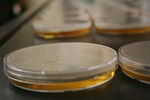Agar
 From Conservapedia
From Conservapedia Agar is a hydrophilic colloid polymer consisting of galactose (sugar) subunits, which is found in the cell walls of certain aquatic plant life. It is commonly used as a gel and broth in laboratories, (after being dissolved in boiling water and cooled),[1] and as a food ingredient. Once prepared, it is usually a gelatinous substance (although sometimes it is kept liquid), which is useful for cooking and also ideal for growing microorganisms. In laboratories, The agar gel is usually placed in a Petri Dish (or Petri Plate), and inoculated with one or more bacterial or fungal samples.[2]
In cooking (which was, in fact, its original use), agar is used for a variety of purposes. It is usually sold as flakes, powder, or a bar, and is then liquefied by the user.[3][4] It can be used in place of gelatin, egg whites, and other animal products, making it a favorite of some vegetarians. In some cases, agar keeps its form and texture better than other substances, making it a superior option anyway.[5]
History[edit]
Agar is believed to have been discovered in Japan in the year 1658. A man named Minoya Tarozaemon is credited with this discovery, as is evidenced by a statue in his honor.[6] It proved quite useful in cooking, due to its gelatinous properties and melting point.
Agar media[edit]
As the field of microbiology grew and developed, it became apparent that the broth and bread mediums which were being used were not sufficient for their needs. Both mediums made it difficult to retrieve pure samples, and were not always sufficiently versatile. In 1882, Fannie Hesse came up the creative idea of using agar as a solid medium, after combining her knowledge of her husband's work with her knowledge of cooking. In 1887, Julius Richard Petri then modified the flat glass plates used for testing, developing a culture dish for the new agar media. By the 1890s, the basic agar-filled Petri Dish was readily available, and proved quite useful.[7]
Types of laboratory agar[edit]
A variety of agar types have been developed for various purposes.
| Type | Description | Uses |
|---|---|---|
| Luria Bertani Agar | Non-selective nutrient | Suitable for growing almost any bacteria, as long as any other requirements are met. |
| Blood Agar | Contains animal blood cells | Good for determining how microorganisms' exotoxins effect blood cells[8] |
| Chocolate Agar | Contains sheep blood which can provide the X and V factors necessary for Haemophilus[1] | Good for culturing fastidious organisms such as Haemophilus species and Neisseriagrowth[1] |
| MacConkey Agar | Selective medium which only grows non-fastidious Gram-negative bacteria[9] | Isolates and grows Enterobacteriaceae[9] |
| Miller's LB Agar | Very similar to Luria Bertani, but contents are in different proportions[1] | |
| Neomycin Agar | A kind of blood agar, which is selective | Useful for the isolation of S. pyogenes S. and agalactiae in suspected samples[10] |
| Non-nutrient Agar | Contains no usable nutrience | Cannot feed bacteria, but can be used as a medium for other microorganisms. |
| Nutrient Agar | Offers plentiful, easily consumed nutrience[1] | Can grow a wide variety of bacteria and fungi[1] |
| Sabouraud Agar | Commonly used for fungus cultures[11] | |
| Thayer-Martin Agar | Chocolate agar designed to isolate gram-negative Neisseria gonorrhoeae[1] | Used to test for Gonorrhea-causing bacteria[1] |
| Tryptic Soy Agar | Generic nutrient usable by many microorganisms | Good for studying colony morphology, development of a pure culture (by eliminating microorganism contamination), and simply expanding the sample size for further testing[1] |
| XLD Agar |
Sources[edit]
There are different kinds of oceanic plant life from which agar can be extracted. The following are some of the common sources.
- Pterocladia (red algae)
- Pterocladiella (red algae)
- Gelidium (red algae)
- Gracilaria (red algae, lower quality)
- Hypnea (red algae, lower quality)
- Gelidium (higher quality, a.k.a. agar-agar)
- Gracilaria (a.k.a. agar-agar)
- Gelidium
- Gracilaria (requires pre-treating with alkali)
Gelidium is almost always used for laboratory purposes. The other sources are generally used for food.[12]
References[edit]
- ↑ 1.0 1.1 1.2 1.3 1.4 1.5 1.6 1.7 1.8 http://www.sciencebuddies.org/science-fair-projects/project_ideas/MicroBio_Agar.shtml
- ↑ http://www.thefreedictionary.com/agar
- ↑ http://honestcooking.com/how-to-cook-gelatin-agar-agar
- ↑ https://www.thespruce.com/what-is-agar-agar-p2-1000960
- ↑ http://www.onegreenplanet.org/vegan-food/everything-you-ever-wanted-to-know-about-agar-agar
- ↑ http://www.fao.org/docrep/x5822e/x5822e03.htm
- ↑ http://www.labnews.co.uk/features/history-of-the-agar-plate-01-11-2005
- ↑ http://www.scienceprofonline.org/microbiology/blood-agar-bacterial-growth-medium-BAP.html
- ↑ 9.0 9.1 http://microbeonline.com/macconkey-agar-mac-composition-preparation-uses-and-colony-characteristics
- ↑ http://www.bd.com/ds/productCenter/221792.asp
- ↑ http://medical-dictionary.thefreedictionary.com/Sabouraud+agar
- ↑ https://www.mooragar.com/history-of-agar
Categories: [Biochemistry]
↧ Download as ZWI file | Last modified: 02/05/2023 06:58:51 | 35 views
☰ Source: https://www.conservapedia.com/Agar | License: CC BY-SA 3.0
 ZWI signed:
ZWI signed:

 KSF
KSF